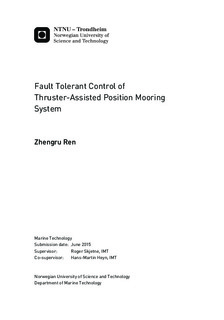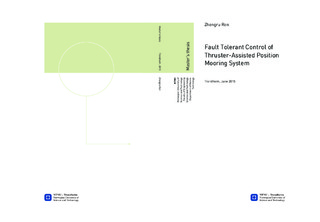| dc.description.abstract | This thesis fo cu ses on the fau lt-to lerant control al gor ithm o f the thr u ster-assiste d posi tio n
moor ing system ( TAPM). TAPM is an energy-efficient and reliable stationkeeping method for
deep water structures. System failures significantly endanger the marine control systems,
and ultimately reduce the reliability and safety during operation and production.
First of all, mooring line breakage is difficult to detect without failure alarms. The statistic
data shows that 50% of the floating production, storage and offloading (FPSO) in the North
Sea cannot monitor line tension in real time, and 78% of them do not have line failure alarms
in 2005. Therefore, line break detection is a crucial issue for the TAPM systems, especially
those built decades ago.
Additionally, the global positioning system (GPS) signals may experience drifts during
some extreme conditions, such as solar events and sudden ionospheric disturbances (SID).
A typical position reference (posref) drift failure mode in a dynamic positioning (DP) system
is that all GPS measurements starts to drift due to SID.
Furthermore, the tensioned-based localization accuracy is not sufficient when the anchors are unknown. Additionally, class society news shows that one anchor lost per 100 ships
a year. To remove breaking anchor and chain is an expensive task.
Finally, the position of the upper moored vessel not only influences the mooring force
arrangement, but also the riser angles at the top and bottom ends. Previous works applies
finite element method (FEM) model and winch control to determine the vessel s equilibrium
point. However, FEM model does not have analytical solution, and winch control is not
applied during practical operation. Therefore, new setpoint chasing algorithm of TAPM is
required to ascertain the safety of the operation and production. First of all, a TAPM toolbox was developed in Simulink. MSS TAPM is a expansion pack of
MSS GNC and MSS Hydro toolbox. MSS TAPM is a Simulink lib for modelling TAPM system,
especially the turret-based mooring system. In this lib, there are a group of different modules and examples, including two mooring line modules, a turret module, a TAPM module,
an animation generation function, etc. Additionally, two papers were refined based on the
works from the specialization project which are submitted to and accepted by the 10th IFAC
ii i
Conference on Manoeuvring and Control of Marine Craft (MCMC2015) after refinement. Another two papers will be submitted after further refinements and more strict verification. | |

